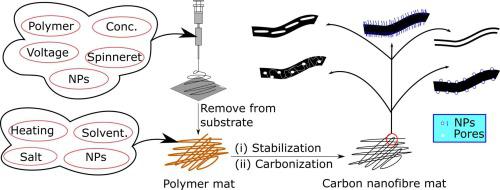当前位置:
X-MOL 学术
›
Nano-Struct. Nano-Objects
›
论文详情
Our official English website, www.x-mol.net, welcomes your feedback! (Note: you will need to create a separate account there.)
Ways of tuning the morphology of electrospun carbon nanofibres for flexible supercapacitors
Nano-Structures & Nano-Objects Pub Date : 2024-03-22 , DOI: 10.1016/j.nanoso.2024.101137 Bidit Lamsal , Rameshwar Adhikari
Nano-Structures & Nano-Objects Pub Date : 2024-03-22 , DOI: 10.1016/j.nanoso.2024.101137 Bidit Lamsal , Rameshwar Adhikari

|
These days, carbon, polymers, metals and hybrids may all be fabricated into 1D multifunctional architectures using electrospinning as a technique. To address the enormous demand for energy storage in the future, flexible, lightweight and efficient devices can be made with the help of carbon-based nanofibres and hybrids. Electrospun carbon nanofibres (ESCNFs) have a potential future in supercapacitor electrodes, even though there are several obstacles (such as cyclic stability, thickness homogeneity and orientation of the fibres) that need to be circumvented to enhance their capacitive performance. In this regard, several strategies have been attempted, such as morphological tuning of pure ESCNFs and the creation of their blends and composites. In this paper, after providing a summary of the current trends, difficulties and constraints in the research and development of supercapacitors as well as the limitations of conventional carbon fibres and composites in energy storage applications, we will discuss the unique features of the electrospinning technique used to create carbon nanofibres. We will also shed light on the importance of theoretical and computational approaches. Particularly, the impact of many factors, including polymer type, blends, spinneret configuration and post-treatment of the fibres and composites on the morphology of carbon nanofibres, and consequently their influence on the capacitive performance of the fibres will be discussed. Lastly, a detailed discussion of the present issues and future potential of carbon nanofibre-based supercapacitors will be provided.
中文翻译:

调节柔性超级电容器用静电纺碳纳米纤维形态的方法
如今,碳、聚合物、金属和混合物都可以使用静电纺丝技术制造成一维多功能结构。为了满足未来对能源存储的巨大需求,可以借助碳基纳米纤维和混合材料制造灵活、轻便且高效的设备。电纺碳纳米纤维(ESCNF)在超级电容器电极方面具有潜在的未来,尽管需要克服一些障碍(例如循环稳定性、厚度均匀性和纤维的取向)来增强其电容性能。在这方面,已经尝试了几种策略,例如纯ESCNF的形态调整以及它们的混合物和复合材料的创建。本文总结了当前超级电容器研发的趋势、困难和限制,以及传统碳纤维和复合材料在储能应用中的局限性,讨论了静电纺丝技术的独特之处来制造碳纳米纤维。我们还将阐明理论和计算方法的重要性。特别是,将讨论许多因素,包括聚合物类型、共混物、喷丝头配置以及纤维和复合材料的后处理对碳纳米纤维形态的影响,以及它们对纤维电容性能的影响。最后,将详细讨论基于碳纳米纤维的超级电容器的当前问题和未来潜力。
更新日期:2024-03-22
中文翻译:

调节柔性超级电容器用静电纺碳纳米纤维形态的方法
如今,碳、聚合物、金属和混合物都可以使用静电纺丝技术制造成一维多功能结构。为了满足未来对能源存储的巨大需求,可以借助碳基纳米纤维和混合材料制造灵活、轻便且高效的设备。电纺碳纳米纤维(ESCNF)在超级电容器电极方面具有潜在的未来,尽管需要克服一些障碍(例如循环稳定性、厚度均匀性和纤维的取向)来增强其电容性能。在这方面,已经尝试了几种策略,例如纯ESCNF的形态调整以及它们的混合物和复合材料的创建。本文总结了当前超级电容器研发的趋势、困难和限制,以及传统碳纤维和复合材料在储能应用中的局限性,讨论了静电纺丝技术的独特之处来制造碳纳米纤维。我们还将阐明理论和计算方法的重要性。特别是,将讨论许多因素,包括聚合物类型、共混物、喷丝头配置以及纤维和复合材料的后处理对碳纳米纤维形态的影响,以及它们对纤维电容性能的影响。最后,将详细讨论基于碳纳米纤维的超级电容器的当前问题和未来潜力。



























 京公网安备 11010802027423号
京公网安备 11010802027423号